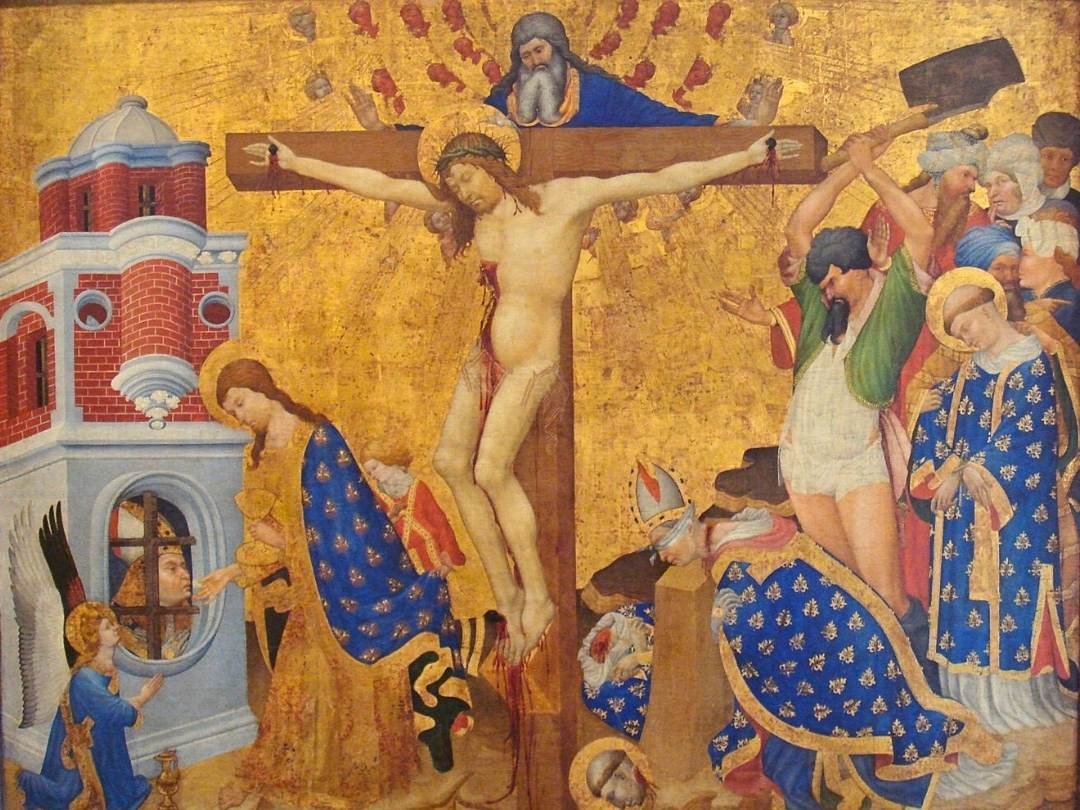Paris, Musée du Louvre
The court of the Valois Dukes of Burgundy was the one of the most splendid in Europe in the fifteenth century. The dukes were art patrons extraordinaire, commissioning everything from tapestries to tombs to paintings, all designed to display the glory of the House of Burgundy.
Among their greatest commissions was at the Carthusian monastery of Champmol, near the Duchy’s capital of Dijon, which was designed to house the dukes’ elaborate tombs created by one of the greatest sculptor’s of the day, Claus Sluter. Everything destined for the monastery was designed to glorify the duchy and it was Duke John the Fearless (1371–1419) who commissioned his court painter and valet de chambre, Henri Bellechose, to paint this splendid altarpiece for the Church of the Holy Trinity at Champmol.
The first duke, Philip the Bold, had married Margaret III, heiress of Flanders, in 1369 and thus, after this date, the Duchy of Burgundy included both the region of Burgundy around Djion, as well as the Southern Netherlands. Bellechose was from the Southern Netherlands (i.e. modern day Belgium) but travelled to Dijon early in the 15th century to work for the dukes. He created altarpieces, decorative works, coats of arms and anything else the dukes might need and at the height of his career, Bellechose had a studio with 8 assistants and 2 apprentices.
This altarpiece was one of his earliest commissions shortly after being named court painter and Bellechose was clearly intent on impressing his patron. Ducal records authorised the purchase of materials for the painting in May 1415; no small sum as gold and blue were among the most costly pigments. Bellechose worked remarkably fast and was paid for the completed work in 1416.
The resulting panel is a lively depiction of the martyrdom of St Denis, the patron saint of Paris (the dukes were a cadet branch of the royal Valois dynasty of France). At the centre is the crucified Christ accompanied by God, the Holy Spirit and a radiating golden aura populated with red cherubs and angels. To either side of the cross are two episodes from the life of St Denis.
St Denis, according to Gregory of Tours, came from Italy to bring Christianity to Gaul and was named the first bishop of Paris around 250. He was martyred for his faith along with his companions Rusticus and Eleutherius by being beheaded on the highest hill in Paris (now known as Montmartre). According to the 13th-century Golden Legend (an inventive retelling of the lives of the saints), St Denis then picked up his head, walked 2 miles to the present location of St Denis Cathedral where he died (thus St Denis is often represented carrying his own head).
To the left of the panel, Bellechose depicts St Denis in a red brick prison leaning his head out of a remarkably low window to receive communion from Christ himself, accompanied by golden haired angels. Christ wears the same royal blue and gold cope as St Denis on the right side of the painting, where in three distinct scenes Denis stands before a heathen mob with his hands bound and with a halo around his tonsured head, then kneels as a trouser-less executioner takes a second swing at his neck and finally his head and body lie separated on the ground.
The unrealistic dimensions and overlapping pictorial space were accepted techniques for packing in many layers of a complicated story – for a medieval altarpiece legibility was the goal, not realism. Bellechose was to tell the saintly story, demonstrating Denis’ piety, conviction and sacrifices as well as to create a glorious piece of medieval aesthetics that would reflect well on its ducal patron; he succeeds on both counts.
The vivid red, blue and gold dazzle the eye, creating an golden otherworldly atmosphere, and the figures move with a courtly elegance, all characteristics of the International Gothic style, of which Bellechose was a master. This was a panel worthy of a duke.
Contemporary Works
1413–16 Limbourg Brothers: Les Très Riches Heures du Duc de Berry, Chantilly, Musée Condé
c1420 Lorenzo Monaco: Annunciation, Florence, Santa Trinita
Categories:
- Northern Renaissance

